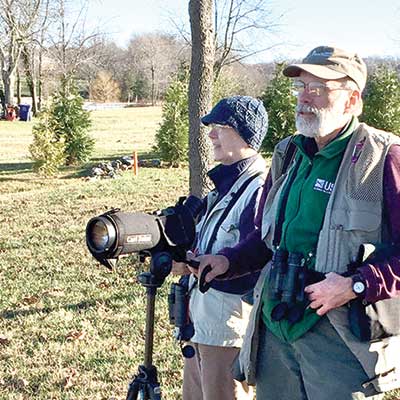
To learn more about winter waterfowl populations through citizen science, the Northern Neck Chapter of the Audubon Society (NNAS) is seeking volunteers to assist in a census count of these fascinating birds February 5-6.
This Northern Neck and Middle Peninsula Winter Waterfowl Count, focusing on the Lower Rappahannock-Potomac rivers, tributaries and adjacent lands, is sponsored in 2022 by NNAS and the Northern Neck and Middle Peninsula Chapters of Virginia Master Naturalists.
This count was started in 2019 modeled after a Winter Waterfowl Count originated by the Audubon Society of Northern Virginia (ASNV) focused on the Northern Virginia Counties along the Potomac that began in 2008, said NNAS president Kevin Howe.
While ASNV focuses on the Potomac, and inland areas where waterfowl can be found, the Middle Peninsula and Northern Neck count includes both the lower Potomac and Rappahannock rivers along the Middlesex, Essex, King George, Westmoreland, Richmond, Lancaster and Northumberland counties.
“Most of the waterfowl we see in the winter have migrated to the area from parts north. Our waterfowl habitats in North America face potentially substantial and unfavorable effects from climate change in their breeding habitats across Canada and Alaska, as well as wintering habitats down the east coast,” said Howe.
“Our Chesapeake region marshes are quite significant and necessary wintering grounds that will potentially be inundated by rising sea levels with the result of significantly reducing their capability to support waterfowl with food and shelter,” he said.
“Counts such as this one will help scientists document and understand any changes in waterfowl populations,” continued Howe. “Vast decreases were seen in waterfowl populations in the early 1900s but through regulations and work by biologists, conservationists and hunters, North American waterfowl made some spectacular recoveries.
“But decreases are being seen again and this count creates an important continued database for tracking and identifying the abundance and health of waterfowl populations and their winter food and shelter. Excessive rains caused high water and excessive sedimentation in the spring of 2018 limited the amount of sunlight for production of submerged aquatic vegetation, thereby largely reducing the major food source for wintering waterfowl. So, in 2019 and into 2020, our waterfowl counts saw a decline in the expected totals of some species,” he said.
The Northern Neck count concentrates on documenting about 60 species birders would expect to see on or along the water from eagles and ducks to scaups and herons. Over half of these birds are winter inhabitants leaving in spring to breed and spend summers in more northern regions, said Howe.
“This is a rather fun count to participate in and prevailing in the face of the February weather always adds to the feeling of accomplishment when you finish,” said Jeff Wright, former NNAS Board member and the founder and compiler of the Northern Neck and Middle Peninsula Winter Waterfowl Count.
Volunteers can participate on either day or both. Birders of any and all skill levels are invited to participate. The count will be conducted under COVID-19 protocols. This means small teams of family or friends, perhaps in separate cars as well as counting from home and/or neighborhood for those that are within the Potomac and Rappahannock watersheds and have access to waters, wetlands and lands associated with waterfowl habitats.
The count has the region divided into sectors with an experienced leader for each section who can suggest areas to cover and will coordinate the count and team of two to eight people in the sector, so duplications are minimized. Volunteers are asked to spend 2-3 hours identifying and counting the waterfowl around rivers, the bays and wetland-marsh areas.
To participate, contact Wright at pec11908@mac.com.


